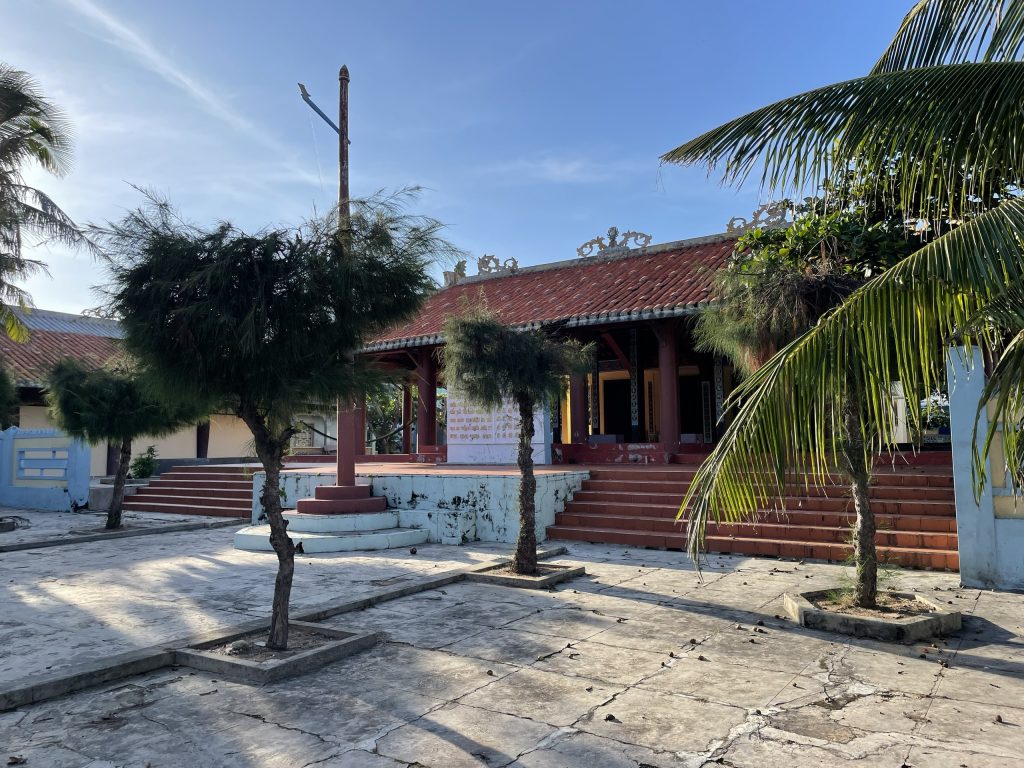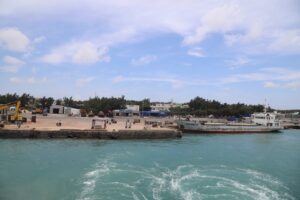Phu Quy island district boasts a rich history and long-standing cultural traditions. With 35 historical and cultural relics of various types and ages spread across its natural area of nearly 17.82 km², the island stands as a vivid testament to the efforts of the pioneers who developed and built it.
These relics demonstrate the enduring vitality of the local people who, for centuries, have thrived amid the vast ocean, highlighting the proud heritage of the Phu Quy people living on this remote island. Among these 35 religious and spiritual sites, three are classified as National Cultural-Historical Relics and seven as Provincial-level Relics. Below is a brief overview of the recognized historical and cultural relics in Phu Quy district for visitors to explore and learn about the island’s unique coastal cultural identity.
Linh Quang Pagoda Scenic Site
Since its foundation, locals have named this pagoda “Linh Quang Tu,” wishing for its sacred radiance to bring peace and happiness to the islanders. Linh Quang Pagoda was the first temple associated with the spread of Buddhism on Phu Quy. Beyond its picturesque setting, it stands out for its historical, literary, and artistic value among the island’s temples.
Linh Quang Pagoda is a renowned ancient temple known for its scale, architectural artistry, religious significance, and rituals, featuring diverse natural scenery deserving of its title as a scenic spot on Phu Quy. According to genealogical records, the pagoda was constructed and restored in 1747 (Dinh Mao year), during the reign of King Le Hien Tong, under the 8th year of Canh Hung era. As of 2017, the pagoda is 270 years old and among the oldest in Binh Thuan province. For its outstanding historical and cultural value, Linh Quang Pagoda was recognized as a National Scenic Site under Decision No. 51 QD/BT on January 12, 1996, by the Ministry of Culture and Information.
Van An Thanh
Located on a white sandy beach near the sea in Trieu Duong Hamlet, Tam Thanh commune, Van An Thanh’s name reflects the local fishermen’s wishes for a peaceful and prosperous life. The temple worships the Whale God (Ca Ong), along with local guardian deities and pioneer ancestors. Established in 1781 (Tan Suu year), Van An Thanh is the oldest of its kind on the island.
The temple houses the skeleton of a sperm whale over 17 meters long, with 50 vertebrae and 30 pairs of lower-jaw teeth. Legend says the whale weighed around 40 tons when it washed ashore. The skeleton has been restored and is now displayed in the Whale Bone Exhibition House within the temple grounds.
Van An Thanh, with its preserved marine cultural artifacts over 236 years (as of 2017), is considered one of the world’s oldest maritime museums. Recently, oceanographers and foreign tourists have shown great interest in the site’s preservation efforts. Van An Thanh serves as a historical witness to the island’s development. It continues to pass down its rich history, culture, arts, and folk traditions while gradually improving and phasing out outdated ceremonial practices. It was recognized as a National Historical-Cultural Relic by the Ministry of Culture and Information under Decision No. 51/QD/BT on January 12, 1996.
Princess Ban Tranh Shrine
Located in Long Hai commune, this shrine honors Princess Ban Tranh of the ancient Champa Kingdom. It was built by the Cham people in the late 15th or early 16th century.
Legend has it that Princess Ban Tranh was exiled to a deserted island for disobeying her royal father. Accompanied by servants and given a sailboat, she and her followers began cultivating the land, fishing, and establishing a new life. She is credited with introducing crops and guiding the people in agriculture and crafts, founding villages and shaping island life. In gratitude, the Cham and Phu Quy people honored her as “Lady of the Realm.”
Her annual death anniversary is commemorated on the 3rd day of the Lunar New Year, attracting most island residents due to its timing. The shrine is a significant cultural and historical relic reflecting the intercultural exchange between the Vietnamese and Cham communities in a remote island setting. It exemplifies the richness of Phu Quy’s folk culture. Recognizing its historical, cultural, and artistic value, the Ministry of Culture, Sports and Tourism designated the site as a National Historical Relic under Decision No. 227/QD-BVHTTDL on January 28, 2015.
Sai Nai Master Shrine
The shrine (also called Dinh Thay) was built by locals in the late 17th century to worship Sai Nai, a revered Chinese merchant who protected and supported islanders across generations. The shrine stands atop a hill in Phu An Hamlet, Ngu Phung commune (his tomb is in Dong Hai Hamlet, Long Hai commune).
This relic reflects the cultural blending of Vietnamese and Chinese communities in their cohabitation on the island. It preserves folk traditions and is a place of worship maintained for over 300 years by successive Cham and then Vietnamese communities. In recognition of its tangible and intangible cultural values, Binh Thuan Province declared it a Provincial Historical-Cultural Relic under Decision No. 1993/QD-UBND on September 7, 2010.
Lady Chua Ngoc Shrine and Van Thuong Hai
Built in the mid-19th century on a white sand beach in Thuong Chau Hamlet, Ngu Phung commune, this site contains two distinct worship spaces within one complex. The left main temple worships Lady Chua Ngoc (Pô Inư Nagar or Thiên Ya Na Diễn Ngọc Phi—Mother Goddess of the Cham), while the right side honors the Whale God (Nam Hai) and pioneers who founded the village.
The site hosts two major annual festivals: the Spring Ceremony in the first lunar month and the Autumn Ceremony in the eighth. Over its 200-year history, the shrine has been renovated multiple times. It was recognized as a Provincial Historical-Cultural Relic under Decision No. 2958/QD-UBND on November 16, 2007.
My Khe Van (Lang Co)
Established in 1785, My Khe Van has existed for over 231 years. It is a folk religious institution linked to the whale-worshipping tradition of My Khe village fishermen. The site reflects their enduring seafaring livelihood and village-building efforts.
Three major rituals occur annually: the Spring Offering, the Autumn Offering, and the “Ancestor Worship” on the 20th day of the 4th lunar month. The Spring Offering (January–March) prays for peace, good weather, and bountiful fishing. The Autumn Offering (July–September) expresses gratitude to the Whale God. The Ancestor Worship commemorates the first whale deity that washed ashore and was enshrined.
Recognizing its unique cultural significance, the site was designated a Provincial Historical-Cultural Relic by Binh Thuan Province under Decision No. 2154/QD-UBND on October 30, 2012.
Hoi An Dinh-Van
Built in the late 18th century in Trieu Duong Hamlet, Tam Thanh commune, this dual-function structure worships the village guardian deity, the Whale God, and ancestral pioneers. It represents both agricultural and fishing traditions.
Three main ceremonies are held each year: two in spring and autumn and one on the 1st day of the 6th lunar month. It was recognized as a Provincial Historical-Cultural Relic under Decision No. 2155/QD-UBND on October 30, 2012.
Trieu Duong Village Communal House
Built in 1773, this communal house honors the village guardian deity and the pioneers who founded the village. It’s a folk architectural relic reflecting rural and fishing life. Over its 241-year history, it has preserved its original name and role as the cultural nucleus of the village. It was designated a Provincial Historical-Cultural Relic under Decision No. 2959/QD-UBND on November 16, 2007.
Long Hai Village Communal House
Also known as “Nha Vuong” or “Nha Ong Cha,” it was built in the late 18th century. This house served as a place of worship and village meetings. It honors the guardian deity and early settlers who established the village. Two annual ceremonies occur in the 1st–2nd and 7th–8th lunar months.
After more than 200 years, it still holds tangible and intangible cultural value, including Han-Nom documents and historical artifacts from Long Hai village’s past. It was designated a Provincial Historical-Cultural Relic under Decision No. 1995/QD-UBND on September 7, 2010.
Ba Chua Ngoc Shrine (Cay Da Temple)
Located in Quy Hai Hamlet, Long Hai commune, at the foot of Mount Cao Cat (a famous scenic spot), this shrine was built by Vietnamese settlers in the early 19th century to worship Thiên Ya Na (Pô Ina Nagar), the Cham Mother Goddess. Vietnamese islanders prayed to her for peace and prosperity.
Besides Thiên Ya Na, the shrine also worships Bach Ma Thai Giam (White Horse Eunuch), and early settlers. The shrine reflects the religious fusion of Vietnamese and Cham beliefs and is a preserved site of local spiritual life.










